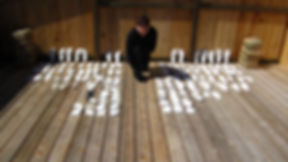top of page

Castings
After my first sighting I knew that if I was going to talk about my sighting I should have some sort of evidence to support my claims. I worked tirelessly heading out to different areas of the Sierra Nevada Range casting tracks. It was not until later that I spread out my collection and started to look at my castings as a whole. It was then I started to discover some common characteristics about them. They all appeared to look very much like on another but had characteristics that distinguished them from one another. Here is a video exploring the possibilities of these anatomically mysterious tracks.
Below is an example of what I mean when I talk about ratios. This track was taken in the Sierra Nevada Mountain range going across a drying up waterway and then heading cross country at around 10,000 ft elevation. There is a ruler next to the cast to get a better appreciation of what I am representing.
As you can see this is an 11 inch track that could be ascertained as of human origin but upon closer inspection there are things here that are much different than human. Let's start from one end of the foot to the other for better gathering of all the data that is present here. Look at one of your own bare feet for a comparison.
Let's first look at the hallux. This big toe is in fact really big here at around 2 inches wide, as a matter of fact the only times I have seen a toe this size is from some sort of inflammation process, commonly diabetes. At this point antibiotic therapy is no longer the choice of treatement but rather amputation. Gout is another disease process however the inflammation would go beyond the hallux and normally presents itself as a large bulge at the metatarsal joint but the bulge can present elsewhere often in the distal points of the extremities. There are other disease processes and anomalies but these two would be the most pertinent.
Now lets look at the toe angle going from the hallux to the 5th toe. The angle is far greater than what is found in the general human population. Take a look at your foot and compare the angle to yours. What my data has been showing is that this angle can increase or decrease based on the terrain being crossed. I am not only seeing a great vertical flexibility but also a great horizontal flexibility in some of my other casts ( I will be doing a video on this in more detail).
The heel is fairly robust considering the overall length of the foot and appears to have a slightly shorter calcaneal region. The mid foot shows somewhat of an arch with evidence of muscle movement frozen in time in the casting. Whoever this individual is they are very muscular based on the compression characteristics of the casting. If in fact there is great range of motion that can be created based on terrain traversed, then collateral ligaments as well as tendons would be needed as well as the ability to flex to these ranges without compromising joint capsules. In the female human population the hormone "Relaxin" softens cartilage and ligaments specifically in the pelvis in preparation of childbirth. In males the purpose is not clear but is believed to be linked to the testes and instrumental in male development. Could there be a mixture of added anatomy and raised Relaxin (hormone) levels to create this flexibility ?









bottom of page